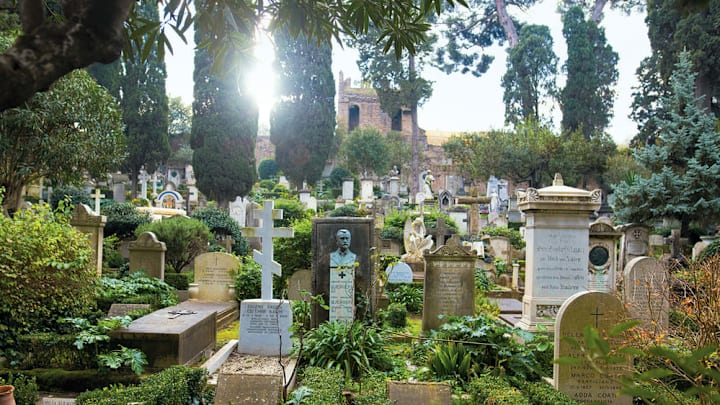Falling leaves, stunning statuary, and famous graves—here are a dozen picturesque international spots to rest in peace.
You don't have to be morbidly curious to enjoy a good graveyard, author Loren Rhoads writes in her new book, 199 Cemeteries to See Before You Die. Besides goths and genealogists, cemeteries appeal to "art lovers, amateur sociologists, birdwatchers, master gardeners, historians, hikers," and the list goes on. For many people, cemeteries have aesthetic appeal: "In addition to the fascinating stories they contain, cemeteries can be open-air sculpture parks full of one-of-a-kind artwork. They provide habitats for birds and wildlife, as well as arboretums and gardens of surprising beauty." The dozen cemeteries below—all featured in the new book—are among the most eye-catching on foreign shores.
1. IL CIMITERO ACATTOLICO DI ROMA // ROME, ITALY

In the 18th century, the pope set aside a field near a Roman-era pyramid for the burial of non-Catholic foreigners. The young poets John Keats and Percy Shelley are buried here—the latter after he died at sea and was found on a beach with a book of Keats in his pocket. Near Shelley's grave is a statue that has been copied around the world—the Angel of Grief Weeping Over the Altar of Life by William Wetmore Story.
2. MIROGOJ CEMETERY // ZAGREB, CROATIA

This cemetery was constructed on the estate of Ljudevit Gaj, a 19th-century linguist, at the foot of Medvednica Mountain. Austrian architect Hermann Bollé designed the interior of one wall as a neo-Renaissance arcade, now filled with memorial statuary.
3. SKOGSKYRKOGÅRDEN // STOCKHOLM, SWEDEN

This burial ground was a collaboration between two of Sweden's most famous architects, Gunnar Asplund and Sigurd Lewerentz, who transformed a former quarry into a beautiful site where modest gravestones are absorbed into the forest and meadows.
4. REILIG ODHRÁN // ISLE OF IONA, SCOTLAND

This island graveyard is considered the Westminster Abbey of Scotland—it's the resting place of many Scottish, Irish, and even Norwegian rulers. The reilig (Gaelic for graveyard) lies beside Saint Oran's chapel, which is home to a mysterious stone called Clàch Brath. Legend has it that when the stone is worn through, the world will end.
5. PÈRE LACHAISE // PARIS, FRANCE

When it opened in 1804, Père Lachaise was a revolutionary cemetery—it offered a gravesite to anyone who could afford it, regardless of denomination, and allowed families to purchase burial space in perpetuity. Today the graceful monuments and many famous burials (including Oscar Wilde and Jim Morrison) make it the most-visited cemetery in the world.
6. HIGHGATE CEMETERY // LONDON, ENGLAND

Highgate was envisioned as a garden cemetery where Londoners could escape the smoke and noise of the city. Despite suffering from neglect during the mid-20th century (when weeds and foxes took over the graves), today it fulfills its planners' vision once again, and the graceful paths serve as a fitting resting place for some of England's most illustrious dead, such as Karl Marx and Douglas Adams.
7. CMENTARZ POWĄZKI // WARSAW, POLAND

More than a million people may be buried in Powązki cemetery, although it's hard to say for sure because burial records were lost in World War II. However, some of the most famous names in Polish arts and culture now rest there. Since 1975, celebrities have gathered at the cemetery each year on All Saint's Day to raise money to restore the site.
8. OKUNOIN CEMETERY // KOYASAN, JAPAN

The largest burial ground in Japan, Okunoin Cemetery is home to more than 200,000 graves, marked with everything from traditional Buddhist monuments to a statue in the shape of a giant rocket ship. One plot that belongs to a pest control company is in memory of all the termites they've killed. Another area, the Hall of Lamps, is lit by 10,000 lanterns. It's said that some have burned for 1200 years.
9. SOUTH PARK STREET CEMETERY // KOLKATA, INDIA

The British opened the South Park Street cemetery in 1767. For more than a century, it was the largest Christian cemetery in Asia—and an early adopter of the modern idea of a burial ground with individualized graves unattached to a church. Obelisks, pyramids, and mausoleums now jam the small cemetery, which is also rich in tropical vegetation.
10. STARÝ ŽIDOVSKÝ HŘBITOV (OLD JEWISH CEMETERY) // PRAGUE, CZECH REPUBLIC

Founded in the early 15th century, this 2.5-acre cemetery served as the only Jewish burial ground in Prague for three centuries. It's now 12 layers deep and covered by 12,000 surviving tombstones, although as many as 100,000 people are buried there. An adjacent museum tells the poignant story of Prague's Jewish community.
11. CEMENTERIO DE LA RECOLETA // BUENOS AIRES, ARGENTINA

Once a vegetable garden tended by monks, Recoleta Cemetery is now the cemetery of choice for wealthy Argentinians, who have filled it with marble portrait sculpture inspired by European cemeteries. Eva Peron (a.k.a. Evita) was buried here in a tamper-proof tomb after her body went missing for 16 years.
12. CIMITERO MONUMENTALE DI STAGLIENO // GENOA, ITALY

Spread over 250 acres, Staglieno is considered a kind of open-air museum, chock-full of one-of-a-kind marble artwork. Many of its sculptures were commissioned pre-need, so the living could enjoy them before being buried beneath them. One of the most famous (shown above) is a grieving angel carved by Onorato Toso around 1910 for the Ribaudo family.

The text above is adapted from 199 Cemeteries to See Before You Die.
